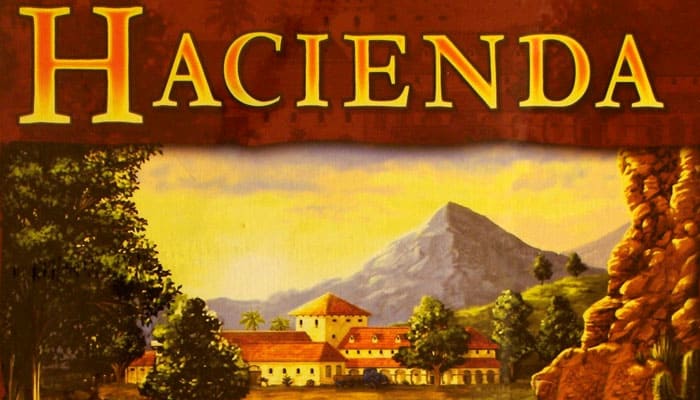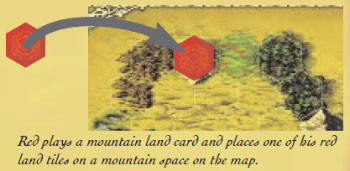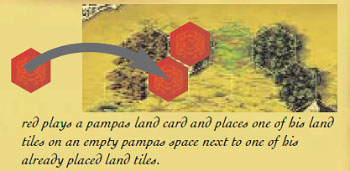
Game Components
- 1 game board
- 80 land cards
- 72 animal cards
- 80 hexagonal land tiles
- 18 water tiles
- 150 round animal tiles
- 9 neutral haciendas
- 8 harvest chips
- 5 haciendas
- 72 money bills
- 5 rule summaries
- 1 rule booklet
Object of the Game
The players are estanzieros (large landowners) in Argentina. They acquire land and animals, build estanzias (haciendas), harvest and sell animals at market. The winner is the player who has most important estanziero at the end of the game; that is, who scores the most points.
Players earn points for access to markets and water, for land chains and haciendas, and for money.
Setup
Game board: the players choose one side of the game board and place it in the middle of the table. We recommend player use the symmetrical map for their first game.

Each player takes 1 hacienda and 30 animal tiles of a color, 20 pesos starting capital, and 1 rule summary.
The players place their haciendas as scoring markers on the start space of the scoring track. The animal tiles have different animals pictured on the front and back sides.
Shuffle the 80 land cards. Each player takes 8 land cards as his starting hand. Place the remaining cards as a face down supply next to the board. Draw 4 land cards from the land supply and place them face up next to the board.
Shuffle the 72 animal cards and randomly remove, without looking at them, several cards, depending on the number of players, from the game.
Each player takes 4 animal cards, adding them to his hand. Draw 4 animal cards from the animal supply and place them face up next to the board. Divide the remaining animal cards into two equal stacks. Place one stack face down next to the face up animal cards as a supply, the other stack is set aside for now.
Place all hexagonal land tiles as a supply next to the game board.
Place 4 water tiles (number 1 tiles) on the 4 water spaces on the game board. Place all remaining water tiles next to the board as a supply.
Place the appropriate number of neutral haciendas and harvest chips as supplies next to the game board.
The players choose a player to manage the game money.
Game Play
The players choose a starting player, and players take turns in clockwise order. On a player's turn, he takes up to 3 of the following actions in any order:
- 1 object buy (land card, animal card, hacienda, water tile)
- 1 card play (land card or animal card)
- 1 harvest
Object Buy
| A player can buy from the bank: | |
|---|---|
| 1 land card from the supply | 2 pesos |
| 1 face up land card | 3 pesos |
| 1 animal card from the supply | 2 pesos |
| 1 face up animal card | 3 pesos |
| 1 hacienda | 12 pesos |
| 1 water tile | 12 pesos |
1 land card buy (several per turn)

The player pays the required amount to the bank and adds the card to his hand. He can play the card immediately, but this is another action! See 1 card play, below. When a player buys a face up land card, he immediately replaces it in the display by drawing a new land card from the supply. He could buy this just drawn card in a further action.
1 animal card buy (several per turn)

The player pays the required amount to the bank and adds the card to his hand. He can play the card immediately, but this is another action! See 1 card play, below. When a player buys a face up animal card, he immediately replaces it in the display by drawing a new animal card from the supply. He could buy this just drawn card in a further action.
1 hacienda buy (once per turn)

The player can buy only 1 hacienda per turn. The player pays 12 pesos to the bank, takes 1 hacienda (as long as there is 1 left in the supply) and places it immediately on any of his land tiles or animal tiles that does not already have a hacienda. When scoring, 1 hacienda earns a player 1 point for each land tile in the chain or each animal tile in the herd.
1 water tile buy (once per turn)

The player can buy only 1 water tile per turn. All water tiles, regardless of their size, cost 12 pesos. The player plays the 12 pesos to the bank, takes the water tile of his choice (as long as there are some in the supply), and places it on any empty pampas space, if it is a single water tile, or on several empty pampas spaces, if it is a larger water tile. During scoring, a water tile earns a player 1 point for each of his land tiles or animal tiles that are adjacent to the water tile.
Card Play
land card


When a player plays a land card, he takes a land tile of his color from the supply and places it on any empty land space on the map that matches the land type of the card played.
Note: the land tiles are two-sided with different player colors on each side.
When a player plays a pampas land card, he must play his land tile on a pampas space adjacent to one of his already placed land tiles.

It can happen late in the game that a player plays a land card, but there are no empty land spaces of that type. In this case, the card is treated as a pampas land card. In such a case, for example, if a player plays a mountain land card and there are no empty mountain spaces, he must place his land tile on an empty pampas space adjacent to one of his already placed pampas tiles.
After playing the land card and placing the tile, the player discards the land card.
Land chains
A land chain is made up of 2 or more land tiles of the same color that are connected to each other on the map. A chain of 3 or more tiles will earn the player points during scoring.
Single land tiles and 2 tile chains do not earn players points during scoring.
Tip: players should try to create chains of 3 tiles or more.
Animal card

When a player plays an animal card, he takes one of his animal tiles showing the same animal and places it on an empty pampas space on the map, adjacent to one of his land tiles or one of his animal tiles, showing the same animal. A herd (one or more connected animal tiles) can only be with animals of the same kind. However, different animal herds may be adjacent to each other.
After playing the animal card and placing the tile, the player discards the animal card.
Note: the animal tiles have different animals on each side.
Tip: when placing animal tiles, players should plan to leave empty pampas spaces for water tiles to be played later.
Market

When a player places an animal tile adjacent to a side of a market, the player earns money. If a player places several animal tiles adjacent to market sides in a turn, he earns more money.
For each market side, the player earns money. The amount the player earns is calculated using the following formula:
number of animal tiles in the herd + number of land tiles = number of pesos.
By "number of land tiles" it means all land tiles that are connected to any tile in the herd.
Note: each side of a market may only be scored once. Thus, when a player increases a herd, but does not reach a new market side, he earns no money.
Note: when a player reaches a market side with a herd, even if with just 1 tile, he scores and closes this side for further payments.
Tip: players should try to reach as many markets as possible with their herds.
Hardvest

A player can earn money in two ways. Either he brings a herd to market (see above) or he places a harvest chip. To place a harvest chip, the player takes a chip from the supply and places it on any land tile of one of his land chains, if the chain has no other harvest chip. Then, the player gets money from the bank using the following formula:
number of land tiles in the chain times 3 pesos.
Example: 7 land tiles x 3 pesos = 21 pesos.
If there are no harvest chips in the supply, a player can still harvest. He takes any harvest chip from one of his opponent's chains and places it on his chain, earning money in the normal way. In this way, a land chain may earn money more than once.
Scoring
Animal card supply exhausted
When the last card of the animal supply is bought or used to replace one that is bought, the second stack is activated and becomes the new animal supply. At the end of this round, after the last player has completed his turn, the game flow is interrupted for the interim scoring. When the animal supply is again exhausted, the players finish that round and then end the game with the final scoring.

Both interim and final scoring run the same way. The players score points first for markets, then for land chains, then haciendas, then water, and, finally, for the money that each player has.
The players record their points as they are scored by moving their scoring markers on the scoring track. To speed the process, players should use the rule summaries.
Points for connected markets

Players earn points for each market they are connected to. It matters not how many herds are connected to a market or how many market sides are connected - only the number of markets connected.
Example: a player whose herds connect to 7 markets earns 28 points.
Points for land chains

Award each player his points in clockwise order. Add up all land tiles that the player has in chains of at least 3 land tiles in length. Single land tiles and 2 tile chains are not counted!
The points are scored using the following formula:
number of land tiles times 2 points.
Example: a player has a 7 tile chain and two 3 tile chains. He also has a 2 tile chain and 3 single tiles, but these are not counted. Thus, he scores 7 + 3 + 3 = 13 x 2 = 26 points.
Points for haciendas

Award each player his points in clockwise order. Sum all the land tiles that belong to chains with haciendas and all the animal tiles in herds with haciendasThe points are scored using the following formula: number of land tiles times 1 point.
Note: if a land chain has more than one hacienda, it only counts once.
Example: a player has 2 haciendas; one stands on a land chain of 7 land tiles and the other stands on a herd of 6 animals. Thus, he earns 7 + 6 = 13 points.
Points for water tiles

Players score each water tile separately. For each land tile and animal tile that is adjacent to a water tile, the owner of the land or animal tile earns 1 point, regardless of whether the water tile was placed on the board at the beginning of the game or was placed later. After a water tile is scored turn it over. After the interim scoring, turn them all water side up again.
Points for money

Each player counts his money. For each full 10 pesos, he scores 1 point.
Example: at game end, a player has 28 pesos. Thus, he scores 2 points.
End of the Game
The game ends after the final scoring. The player with the most points is the winner. If players tie with the most, the player among them with the most money is the winner.
Continue Reading
